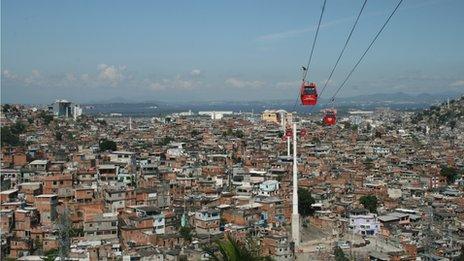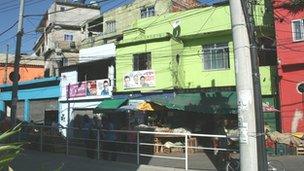Rio's shanty towns spread their wings
- Published

The cable car system has greatly reduced travel times for local residents
The giant shanty town or favela sprawls across the hillsides of northern Rio de Janeiro, thousands of interwoven, ramshackle homes and their flat metal roofs.
With a population of 100,000 people, the Complexo do Alemao favela is one of the largest in the Brazilian city.
It stretches for more than two miles (3.2km), a maze of narrow alleys and stairways.
Amid such poverty and seeming chaos, for first-time visitors it appears incredible that the shanty town has its own modern cable-car system.
Yet there it is, towering above the homemade houses, 155 eight-seat cable cars travelling between six stations built across the favela.
Operational since July of last year, the Teleferico do Alemao cable car system is the most obvious outward example of how the lives of people in Complexo do Alemao have been transformed by a city-wide policy called "pacification".
Military action
Under the dramatic first stage of pacification, armed police units [Pacifying Police Units] - backed by soldiers and marines - have been going into Rio's favelas since 2008 to drive out the criminal gangs, and establish the first permanent police presences in what had often been no-go areas for security officials.

Eduarda La Rocque wants social services in the favelas to be as good as in the wider city
In the case of Complexo do Alemao, 300 police officers and troops went in at the end of 2010, with tanks and helicopters. They met little resistance, as the gang members chose to flee rather than fight.
With the shanty town secured, staff from Rio's municipal authority could start to safely go in to provide the second part of the pacification programme - social services such as schools, healthcare centres, and rubbish collection.
The decision was also made by the government of the wider Rio de Janeiro state to build the cable-car system, to enable the residents to move about far more quickly. It was chosen instead of roads or a rail system because the favela is so densely packed with houses, it was the less disruptive option.
The cable cars enable residents to get from one end of the favela to the other in just 16 minutes. To walk it would take two hours, and each local person gets a free return ticket every day.
The system also connects to Rio's railway network, enabling the people of Complexo do Alemao to get quickly into the city centre, and thus be better able to secure jobs in the real economy.
New schools
So far 30 of Rio's favelas, including many of the largest, have been pacified since 2008, benefiting a combined population of 400,000. This leaves 1.1 million people still living in hundreds of other favelas across the city still to benefit from pacification.

The retail sector in Rio's pacified favelas is continuing to grow, with many new entrants
Eduarda La Rocque, president of the Instituto Pereira Passos at Rio's municipal government, is the official in charge of social pacification.
She says: "Our mission is to provide social services in as good a quality as the rest of the city, to improve the quality of life for the communities.
"We now have something like 150 new schools [in the favelas] to provide a better service for the children."
By improving the social conditions of favelas freed from the control of drug gangs, the aim is to both help better their economies, and the employment prospects of the residents.
Ms La Rocque says that one key result of the pacification scheme is that the pacified favelas are added to the official maps of Rio.
"This is something very important. A young guy who is looking for work [in the wider city], previously he wouldn't have had a zip code in the slums, so we are introducing them to the formal map of the city.
"Also we are trying to provide many training courses in order to prepare the young to access good jobs, and there are many new businesses appearing [in the favelas themselves], so many new opportunities."
Crime fear
But what to do the people living in the favelas think of the pacification schemes?

Prof Marcelo Neri says the big challenge is creating enough jobs for the young people of the favelas
Natalaia Barros, 19, a housewife, says: "The good point is that we barely hear gunshots.
"Things are cleaner, there are more shops, there is more stuff for kids to do.
"We can stay outside, there are no more bandits, gang fights et cetera."
However, Winderson Menezes, a 16-year-old student, says petty crime has actually increased, because fear of the gang bosses had prevented petty crime.
"Before we would feel safer because we knew nobody would do anything wrong," he says.
"We could sleep with doors open and nobody would get in your house. Nowadays, everybody fears being robbed in the community. And a lot of robbing is going on now."
'Tourism boost'
Leading Brazilian economist, Prof Marcelo Neri, president of the country's Institute of Applied Economics Research, says the pacification programme has been a major success, but some challenges remain.

Educational facilities in the favelas have improved
"We did some studies where we showed that there is a very rapid increase in the proficiency of students in those areas [favelas] where there was pacification compared to other ones," he says.
"Another impact is on local businesses [in the pacified favelas]. There is a growth in [local] businesses, but more in bigger businesses, and more of outside businesses.
"This is because, in a sense, the UPP [pacification scheme] is opening up the economies of the favelas to the outside world, and previously they were dominated by the drug gangs."
For Rio in general, Prof Neri says, the programme is of great benefit because it increases the wealth of the wider city, especially as a reduction in crime makes tourists less wary of visiting.
"People will not only come Rio more, but also the favelas will become a tourist attraction themselves," he says.
However, Prof Neri says the biggest problem of the pacification scheme is how the wider Rio economy can offer jobs to the large number of youths in the favelas now getting a better education.
"The youth is the biggest challenges of the pacification, how you offer opportunities to these young people, I think it is a very hard challenge," he says.
Prof Anthony Pereira, professor of Brazil Studies at Kings College London, says the pacification programme is "largely positive".
"I would just hope the government keeps an eye on possible unintended consequences," he says.
"You can see it making these communities desirable for people who haven't been living in them, young people, the more adventurous.
"I don't know of any studies yet, but it could lead to gentrification and rents going up."
However, he says the main concern is the drugs gangs have simply been relocating to favelas yet to the pacified, or to towns just outside of Rio.
"I think this is true, as long as there is still the demand for drugs, but moving out is costly for them."
With Rio set to hold a number games in the 2014 World Cup, and host the Summer Olympics in 2016, Prof Pereira says these events are definitely the force behind the pacification programme, and it should "on balance" be welcomed.
- Published8 January 2012